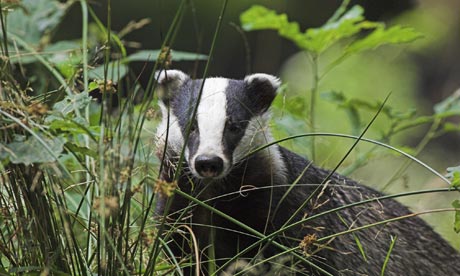Badger cull is a shot in the dark for the government
The coalition's approach to bovine TB has been driven by short-term political calculation and carries some very real risks

The first licence for the autumn badger cull was issued this week. Photograph: Duncan Shaw/Getty Images
Labour knows that tuberculosis in cattle is a major animal health problem. We understand the desperation of farmers affected by this devastating disease. That is why, in government, we set up the randomised badger culling trial (RBCT). It cost £50m and remains the most extensive scientific study, over a 10-year period, on whether cullingbadgers reduces bovine TB.
The study concluded that "the reductions in cattle TB incidence achieved by repeated badger culling were not sustained in the long term after culling ended and did not offset the financial costs of culling. These results … suggest that badger culling is unlikely to contribute effectively to the control of cattle TB in Britain."
Labour's approach in government was led by that science. We continue to be led by it. Sadly, the coalition government's approach to bovine TB has been driven by short-term political calculation. Their "big society badger cull", which issued the first licence on Monday, carries some very real risks and will be bad for farmers, bad for taxpayers and bad forwildlife.
First and foremost, the cull could make TB worse. Localised culling significantly increases the TB risk in neighbouring herds due to a "peturbation" effect, when traumatised badgers move out of cull areas and spread the disease, particularly in the first two years. The new cull will use "hard boundaries", such as roads and rivers that badgers find hard to cross, but the RBCT found that the perturbation effect still occurred when hard boundaries were in place.
Furthermore, the RBCT used cage trapping and shooting, but the new cull will use free shooting as it is cheaper. Free shooting has therefore never been tested and is not supported by the science. The environment department's own risk assessment to ministers raises concerns about the impact of free shooting: "If a different culling strategy to that conducted in the RBCT is used the effect on TB incidence and the degree of the resulting perturbation is uncertain."
The panel of scientists who met at the department on 4 April 2011 stated that vaccination is unlikely to be effective at reducing the impact of peturbation. The government places great emphasis on that scientific meeting at the Department for Environment, Food and Rural Affairs (Defra) and the two-page document it yielded, yet it concluded: "If culling is not conducted in a co-ordinated, sustained and simultaneous manner according to minimum criteria, then this could result in a smaller benefit or even a detrimental effect on confirmed cattle TB incidence."
Worryingly, there is no mechanism in place to measure whether the culling makes things worse or better. The "pilot scheme" in Gloucestershire which got the go-ahead on Monday is in no sense a scientific test of policy. The panel set up to oversee its effectiveness will have a narrow remit: is free shooting humane and can the farmers deliver it? They will not look at the reduction in the number of cattle affected by TB to see if culling saves public money.
The panel will assess whether farmers can shoot more than 70% - but less than 100% - of badgers in an area. But as the government hasn't counted the badgers in cull areas, they will not know what proportion of the population has been killed. If 1,000 badgers are killed, we won't know whether that is part of a population of 1,001 or 2,000. Lord Krebs, the Oxford scientist who instigated Labour's RBCT, has described the government's cull as "a crazy scheme". These pilot culls are a shot in the dark, in every sense of the word.
Another crazy aspect of the culls is that costs will exceed the benefits.Defra's impact assessment states: "For farmers in cull areas, monetised costs exceed expected monetised benefits." So the costs to farmers will exceed the benefits. Hardly a compelling case to sign up for the cull.
Taxpayers will still pay for TB testing, monitoring, issuing licences and judging the effectiveness of the cull. In addition, the costs of providing armed police to manage any public protest at cull sites was not included in the government's cost-benefit analysis produced in 2011. In a written answer to parliament, the government estimated it will cost taxpayers £500,000 per cull area per year to police. Police will also bear the costs of licensing firearms.
And there are a series of further risks. Will the cull wipe out whole badger populations, putting us in breach of the Bern Convention on wildlife protection; will farmers actually be able to deliver the long, hard cull the policy prescribes?
The government is under siege from scientists who rightly object to ministers dressing up the cull as being "science-led". The reality could not be further from the truth. Bovine TB is a terrible disease that needs to be controlled. This cull is not the way to do it.
• Mary Creagh is Labour's shadow environment secretary
No hay comentarios:
Publicar un comentario